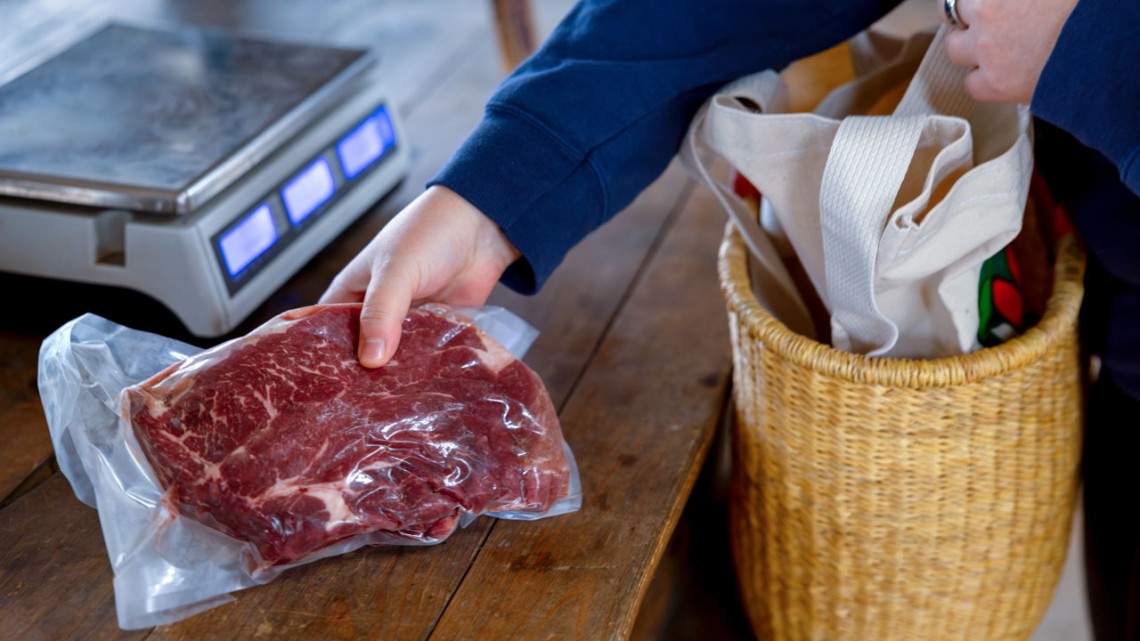
A customer purchases beef at a farmers market.
Scanner data can help NYS farmers boost market sales
By Alison Fromme
Julie and Steve Rockcastle, founders of Green Heron Growers in Cattaraugus County, are always trying to figure out what works and what doesn’t when it comes to selling their grass-fed beef at farmers markets. So after a Cornell study showed them that customers spent less per transaction when the booth was busiest, and more when using credit cards, they decided to make some changes.
“We realized that we could really use another person at the market because we were losing sales,” said Steve Rockcastle, who also doubled the booth size, sped up the checkout process and improved signage so customers would know cash wasn’t required. “It was nice to have that analysis.”
The Rockcastles were among the participants in a study led by Cornell researchers who partnered with 10 New York state livestock farmers using point-of-sale devices that record sales and process credit card payments. The researchers analyzed market transactions to better understand customer behavior and help farmers increase their profits at farmers markets.
“We looked at more than 26,000 transactions and summarized what happened when people became customers,” said Matt LeRoux, M.P.S. ‘09, extension associate at the SC Johnson College of Business and co-author of “Increasing Customer Purchases at Farmers Markets Using Point-of-Scale Scanner Data,” published Dec. 13 in the Journal of the Agricultural and Applied Economics Association. “Then we identified management techniques and opportunities for growth we can test in the future.”
The study also showed that, on average, farmers market customers spent more per purchase on Sundays compared to Saturdays. They bought more during the holiday months of March, April, November and December.
The biggest sales were made at the beginning of the market or even before it opened, and then transaction totals declined substantially by hour thereafter. Ground beef was typically purchased in quantities of two pounds or more.
Customers also purchased more when paying with debit or credit cards. And, when the number of transactions in a five-minute period increased, the dollars spent per transaction decreased.
Scanner data downloaded by farmers and shared with the research team made this study possible. The team collected and processed 2021 data from transactions at 22 New York state markets, including details such as products purchased, payment type and amount spent, and then used statistical analyses to find patterns.
“Traditional retailers like grocery stores have used scanner data for years to better inform how they should market to their customers,” said Todd Schmit, professor of applied economics and policy at the SC Johnson College of Business and co-author of the study. “For farmers, the data was just never available before. So now with the advent of new technologies, we can bring that marketing power to the farmer.”
Farmers do not just vie for customers at the market, they also compete against grocery stores that carry local food products. Plus, earlier research showed that farmers markets are the worst performing sales channel for farms in terms of sales per hour of marketing labor for vegetable farms.
“The competitive environment has changed, so having a better understanding of your consumer really matters,” said Schmit, who believes this study is the first peer-reviewed analysis of customer-level transaction data at farmers markets. “This type of work addresses some of that competitive disadvantage.”
Unlike grocers, livestock farmers cannot selectively stock and sell the most desirable cuts of meat, said Luca Rigotti, M.S. ’23, co-author of the study and research support specialist at the Charles H. Dyson School of Applied Economics and Management. Instead, they market and sell the whole animal, which makes appropriate marketing and pricing critical. “That makes the results that we share perhaps more important for them than it would be for another retailer,” he said.
The findings lead to many specific recommendations to help farmers increase their sales. For example, farmers could attend more Sunday markets, increase product prices and volume at holidays, and bundle products like ground beef.
“What we're saying now is, let’s evaluate a change in your marketing strategy,” Schmit said. “Instead of simply taking a retroactive look, we can actually use this data and the economic methods at our disposal to explore the effectiveness of different marketing practices in real time. And that really excites me.”
Alison Fromme is a writer for the Cornell SC Johnson College of Business.
Media Contact
Get Cornell news delivered right to your inbox.
Subscribe

